Abstract
The Ili River Transboundary Basin is an important area within the Belt and Road Initiative, and its ecological security impacts China–Kazakhstan diplomatic relations and the building of the Belt and Road Initiative. Using the copula method, this study quantifies the vulnerability of vegetation to drought in the Ili River Transboundary Basin based on the Normalized Difference Vegetation Index (NDVI) and the Standardized Precipitation Evapotranspiration Index (SPEI). The vulnerability of vegetation in the Ili River Transboundary Basin is highest in June, with the proportion of highly vulnerable areas reaching 63.29% under extreme drought conditions. As the drought severity increases, the probability of vegetation loss rises, with vegetation being affected the most in June. From May to June, drought-prone areas are mainly located in Almaty Oblast and East Kazakhstan. From July to September, drought-prone areas are mainly found in the Ili River Valley and southeastern Almaty Oblast. Rainfed croplands are most susceptible to drought, while, for irrigated croplands, higher drought severity enhances the mitigating effect of irrigation measures. Vegetation areas are most affected by drought in semi-arid regions, particularly in summer. These findings offer valuable scientific support for drought management and sustainable development in the region.
1. Introduction
Drought is typically defined as an extended period during which water availability falls significantly below the long-term average. It causes widespread negative impacts on ecosystems, agriculture, water resources, and human activities. Against the backdrop of the current climate warming, droughts are projected to occur with a higher frequency and severity [1,2]. Frequent meteorological droughts can limit carbon sequestration capacity by regulating the opening and closing of stomata and modifying structures, thereby negatively impacting terrestrial ecosystems [3]. When the drought intensity exceeds the resilience threshold of a system, it can lead to serious implications for worldwide food security and human survival [4]. Therefore, quantifying drought vulnerability—the likelihood of suffering from drought damage [5]—is crucial for preventing land degradation, maintaining ecological balance, and studying the carbon cycle.
Atmospheric evapotranspiration must be considered in drought research [6]. The SPEI (Standardized Precipitation Evapotranspiration Index) incorporates evapotranspiration in drought assessments and is capable of monitoring drought across different time scales, making it widely used in drought-related research [3,4,5,6,7,8,9]. As remote sensing technology continues to advance, various vegetation indices have been applied to the study of drought impacts on vegetation [10]. The NDVI (Normalized Difference Vegetation Index) is capable of effectively monitoring vegetation activity and environmental conditions across various scales [11], aiding in the investigation of the impact of climate change on vegetation growth and ecosystem structures [12,13]. Many studies have investigated the connection between vegetation and drought across various regions using the SPEI and the NDVI. For instance, Jin et al. [14] explored the sensitivity of vegetation to drought in different seasons in Europe using the SPEI and the NDVI based on Pearson’s correlation coefficients. Li et al. [15] analyzed how drought affects vegetation in the Yellow River Basin using SPEI and NDVI data combined with a linear regression model. Although these studies have offered insights into the connection between vegetation and drought, it remains difficult to determine the critical link between them through correlation analysis alone.
The appropriateness of employing multivariate methods and establishing joint dependency structures to explain the interrelationships among variables was proposed in ref. [16]. While traditional multivariate analyses require uniformity in the marginal distribution of variables, the copula method provides a flexible analytical approach that is not subject to such constraints [17,18]. Early on, the copula theory was widely used in international studies on financial risk and insurance [19], and it is currently applied effectively to the study of hydrological drought characteristics [20,21,22]. Mirabbasi et al. [23] estimated the bivariate relationship between the duration and severity of droughts. Madadgar et al. [24] utilized a three-variable approach to predict the interaction of key characteristics of drought events in climate change scenarios. Apart from simulating multiple different features of the same event, the multivariate joint distribution between random variables can also be simulated by copula functions, and their dependence structure can be modeled. Fang et al. [6] calculated the probability of vegetation loss under different drought conditions in China based on the NDVI and the SPEI using copula functions. The results indicated that vegetation was more affected under moderate drought conditions than under extreme droughts. Jha et al. [25] combined the NDVI and the SPI (Standardized Precipitation Index) using copula, quantitatively analyzing the impact of drought on vegetation in India, with the results indicating that croplands are the most susceptible to drought. Han et al. [26] calculated the likelihood of vegetation damage in Central Asia based on SPEI and KNDVI (Kernel Normalized Difference Vegetation Index) data using copula. The results indicate that vegetation in Central Asia is more susceptible to drought from May to September. Muthuvel et al. [27] used the MSDI (Multivariate Standardized Drought Index) along with XGBoost and copula functions to analyze the effects of future concurrent droughts on the global maize yield. The results show that concurrent drought will have the biggest impact on maize yield in France, Mexico, and Brazil in the distant future. By employing the copula method to quantitatively evaluate drought’s effects on vegetation, the capacity of the region to cope with drought can be improved, thereby promoting the sustainable development of drought-prone areas.
The Ili River Transboundary Basin is an arid and semi-arid region where vegetation plays a crucial role in regulating the local ecosystem [28,29]. As an international river basin between China and Kazakhstan, the ecological and environmental security of the Ili River Transboundary Basin is crucial not only for the development and stability of Xinjiang, but also for the bilateral cooperation between China and Kazakhstan and the comprehensive implementation of the Belt and Road Initiative. Scholars have conducted extensive research on the vegetation response to drought using the copula method. Li et al. [30] employed the vine copula method to quantify the impact of compound extreme conditions of heat and drought on vegetation in Xinjiang. They found that vegetation is most severely affected in August. Moreover, Li et al. [31] established the dependence structure between crop yield and drought scale using copula. The research revealed that long-term drought conditions have the biggest impact on wheat and maize yields. Han et al. [32] conducted a detailed investigation into the response of grasslands to drought using copula in Xinjiang. Their study identified August as the period when grasslands are most vulnerable to droughts.
In the past, scholars have extensively examined the relationship between vegetation and drought, enriching our comprehension of vegetation’s response to drought events and providing valuable research groundwork and theoretical frameworks for subsequent studies. However, there remains a paucity of detailed research on the consequences of drought on vegetation in the Ili River Transboundary Basin. Most studies concentrate on the Xinjiang region or Central Asia, overlooking in-depth examinations of this specific geographic locale within the Ili River Transboundary Basin. Furthermore, existing research often confines its scope to either all vegetation or specific vegetation types, while the differences in drought responses between different vegetation types and climatic dryness areas are neglected. To address these limitations, this study aims to address the following scientific inquiries: (1) to clarify the sensitivity and dependence of vegetation on water deficiency and reveal the differences in water deficiency dependence among different climatic dryness areas and vegetation types, and (2) to quantify variations in drought vulnerability among climatic dryness areas and vegetation types and pinpoint drought-prone regions in the Ili River Transboundary Basin. The results of this investigation will help deepen our comprehension of the repercussions of extreme climate on vegetation, thereby providing scientific support for effective drought resilience and disaster mitigation strategies.
2. Study Area and Data Sources
2.1. Study Area Description
The Ili River Transboundary Basin (72.00°~85.00°E, 42.26°~49.37°N) is situated in Central Asia, primarily within the territories of Kazakhstan and China. The total area of the basin is approximately 1.575 × 106 km2, with about 1.005 × 105 km2 located within Kazakhstan and 5.70 × 105 km2 within China. The geomorphology of the Ili River Transboundary Basin can be divided into three main units (Figure 1a): the first unit is the upper and middle reaches of the river valley within the Tianshan Mountains, with elevations ranging from 4000 to 5000 m in the mountains and approximately 300 m in the valley; the second unit is the downstream alluvial plain, which is relatively flat and features multiple deltas with elevations ranging from 342 to 378 m; and the third unit is the downstream desert area, dominated by aeolian landforms, with elevation ranging from 275 to 342 m. Vegetation dominates the land use in this region, primarily consisting of grasslands, croplands, and forests. Grasslands are mainly distributed within Kazakhstan, croplands are mainly located within China, and forests are mainly found in higher-altitude areas within China (Figure 1c). According to the climate classification system, the region is divided into four climatic dryness areas: arid, semi-arid, semi-humid, and humid (Figure 1b). Based on multi-year average precipitation (Figure A1a), precipitation is less than 200 mm in the arid zone, while, in the humid zone, it exceeds 600 mm and, in some mountainous areas, it can reach up to 800 mm. The arid zone is primarily characterized by grasslands and irrigated croplands, with irrigation having a significant impact on vegetation distribution. In contrast, the abundant precipitation in the humid and semi-humid zones supports the coexistence of grasslands and forests, with the humid zone providing optimal conditions for forest growth. Croplands are further divided into rainfed and irrigated croplands, with the former being sensitive to extreme climates [33]. This study focuses exclusively on the growing season, defined as May to September.
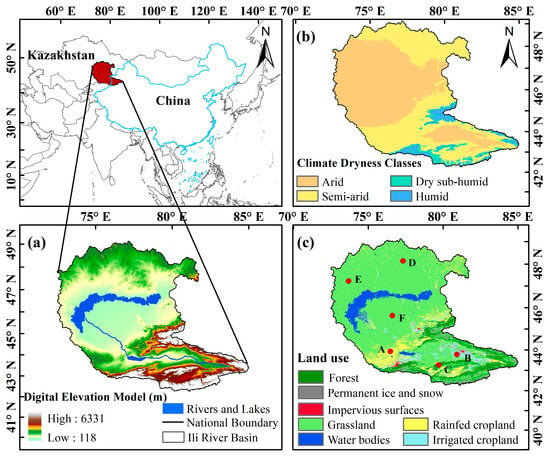
Figure 1.
Overview of the study area. (a) Altitude of the Ili River Transboundary Basin; (b) land cover types in the Ili River Transboundary Basin in 2020. Points A–D represent randomly selected locations for model validation. A represents rainfed croplands, B represents irrigated croplands, C represents forests, and D, E, and F represent grasslands; (c) aridity index (AI). AI data were obtained from the Global Aridity Index Database [34].
2.2. Data Sources
During the period from 2001 to 2022, monthly meteorological data including Potential Evapotranspiration (PET) and precipitation were acquired from the TerraClimate reanalysis dataset. The spatial resolution was 5 km, and the data were accessed from the Google Earth Engine. PET was calculated based on the Penman–Monteith method [35]. Precipitation and PET were used for the calculation of the SPEI. NDVI data from the MOD13A2 were utilized in this study. The resolution of the dataset was 16 days and 1 km. The MVC (Maximum Value Composition) method was employed to convert NDVI data into a monthly scale. To match the resolution of the SPEI, the NDVI was resampled to 5 km. Land cover data were obtained from the GLC_FCS30-2020 product, a global land cover dataset at a 30 m resolution.
3. Methods
This study employed a probability model called copula to quantify the response of vegetation to drought stress. The binary probability model in this study primarily consists of four components (Figure 2). (1) Drought characteristics represented by the SPEI and vegetation condition measured by the NDVI. Here, PRE refers to precipitation, which is used to calculate the SPEI and represents drought. (2) Determination of response time of vegetation to drought. (3) Modeling of the vegetation–drought dependency structure. In this context, SPEI_nm refers to the Standardized Precipitation Evapotranspiration Index (SPEI) at an n-month scale. F1 represents the marginal distribution function of the SPEI_nm sequence. Since the SPEI follows a normal distribution, F1 is the normal (norm) function. F2 refers to the optimal marginal distribution function of the NDVI sequence. C is the copula function, used to describe the dependency structure between the NDVI and SPEI. KS is the Kolmogorov–Smirnov (K-S) test, which assesses the goodness of fit; a higher KS value indicates a better fit. AIC and BIC are the Akaike Information Criterion (AIC) and Bayesian Information Criterion (BIC), respectively, both of which are statistical indicators used for model selection. Lower AIC and BIC values indicate a better model fit. (4) Probability of vegetation loss under different drought conditions. In the Methodology section, a detailed description of the SPEI, SPEI-NDVI correlation coefficients, and copula theory is provided, such techniques collectively forming the backbone of this framework.
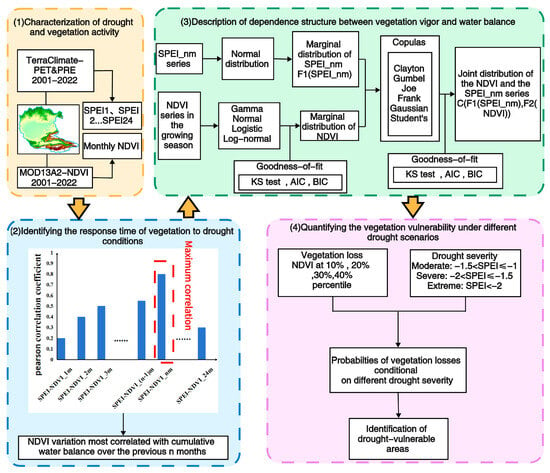
Figure 2.
Schematic diagram of vegetation vulnerability assessment based on copula.
3.1. Standardized Precipitation Evapotranspiration Index
In this study, monthly PET and precipitation data provided by TerraClimate were used to calculate the SPEI on a time scale of 1–24 months. As mentioned in Section 2.2, the PET in this dataset takes into account various meteorological factors. The SPEI results were classified according to the classification standards for wet and dry conditions (Table 1).

Table 1.
Classification of SPEI level.
3.2. Correlation Among NDVI and SPEI
A correlation analysis was conducted between a 22-year NDVI sequence from 2001 to 2022 and the SPEI at different time scales to determine the response time of vegetation to water availability. The relationship between the two variables changes over the growing season due to phenological effects; hence, each month was examined separately. For month i, a Pearson’s correlation analysis was conducted between monthly NDVI values and SPEI sequences across various time scales:
In the equation, corr is the Pearson’s correlation method, i represents month i, ranging from month 5 to month 9, j is the drought time scale, ranging from 1 to 24 months, is the NDVI series for month i, is the drought index for month i, with a time scale of j months, and is the Pearson’s correlation coefficient of and .
In the equation, i represents the month i, j denotes the time scale, VRT stands for vegetation response time, and represents the correlation coefficient. The arg max term refers to the “argument of the maximum value”, which, in this context, means identifying the time scale j (ranging from 1 to 24 months) that maximizes the correlation coefficient.
3.3. Copula Method to Quantify Vegetation Vulnerability
3.3.1. Copula
The copula function imposes fewer constraints on marginal distributions, making it useful for the assessment of drought [6,36,37,38]. The identified response time aids in determining which time scale of the SPEI is correlated with the NDVI. The applied copula is expressed as follows:
In the equation, t is the response time, SPEIt is a dataset with a time scale of t (months), and is the probability that SPEIt is below a certain spei threshold and NDVI is below a certain ndvi threshold. is the joint distribution. C is the copula function. and are the marginal distribution of the SPEIt and NDVI series, respectively.
This study fitted the monthly NDVI data using the gamma, normal, log-normal, and logistic function distributions and selected the optimal marginal distribution and copula based on the AIC and BIC criteria, as well as the KS test. The best marginal distribution function of the NDVI is shown in Figure A2. For the SPEI series, the SPEI follows a normal distribution. From the elliptical and Archimedean families, copulas such as Gaussian, Student’s t, Joe, Frank, Gumbel, and Clayton were selected to construct the dependence relationship. The copula that had the highest p-value and the lowest test statistic was selected as the optimal copula [39]. The AIC result corresponding to the optimal marginal distribution is shown in Figure A3, and the result for the optimal copula is shown in Figure A4.
3.3.2. Assessment of Vegetation Loss Probability
The conditional probability of vegetation activity below a given threshold under different drought conditions is used as a criterion for assessing vegetation drought vulnerability. Given the same drought conditions, an increased likelihood of vegetation loss implies greater ecosystem vulnerability, thus categorizing it as prone to drought.
The conditional probability of vegetation activity dropping below various percentiles are calculated using copula-based joint and conditional distributions. The probability can be represented as follows:
In the equation, is the likelihood that both the NDVI and the SPEI will fall below a specific level. is the probability of the SPEI being lower than a spei value. For instance, the conditional probability of the NDVI being below the 30th percentile under severe drought conditions (SPEI ∈ (−2, −1.5]) can be obtained from the following equation:
In the actual occurrence of drought, managers are more concerned with the vegetation vulnerability under instantaneous drought conditions, namely the conditional probability in specific drought scenarios (SPEI = spei):
The density function of conditional probability of vegetation falling below a specific percentile (NDVI ≤ ndvi) in a specific drought scenario (SPEI = spei) can be represented as follows:
In the equation, c represents the density function of the probability of the copula function, while and denote the probability density function of the SPEI and NDVI. The probability of the vegetation status falling below a specific threshold can be obtained by integrating the conditional probability density over NDVI ≤ ndvi, denoted as dvi.
4. Results
4.1. Sensitivity of Vegetation Dynamics to Water Deficits
Figure 3 illustrates the spatial distribution of the maximum Pearson’s correlation coefficient. The results indicate that, throughout the growing season, there is a predominantly positive correlation, suggesting that the vegetation status in the Ili River Transboundary Basin is mainly influenced by water deficits. Specifically, as indicated by the violin plots in Figure 3, the correlation coefficients between the SPEI and NDVI are concentrated between 0.4 and 0.8 from May to September. Particularly, in June, the mean correlation coefficient is highest and concentrated in high-value areas, indicating that the vegetation status is most sensitive to water deficits in June.
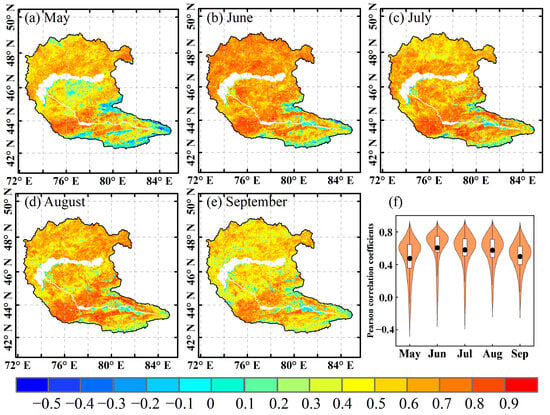
Figure 3.
Between 2001 and 2022, the maximum Pearson’s correlation coefficients between monthly NDVI and SPEI varied across different time scales, ranging from 1 to 24 months. (a–e) represent May to September, while (f) is the violin plot of the maximum correlation coefficient corresponding to May–September, with the black dots indicating the mean values.
Spatially, there is significant spatial heterogeneity in the correlation between the SPEI and NDVI. In the early stages of the growing season (May), semi-arid regions show a higher SPEI-NDVI correlation compared to arid regions, while humid areas exhibit weak or even negative correlations. By June, the correlation in the northern arid regions of the Ili River Transboundary Basin strengthens, while in humid areas, the correlation shifts from weak to positive. Two notable observations emerge: firstly, throughout the growing season, the southwestern region of the Ili River Transboundary Basin consistently demonstrates a strong positive correlation, indicating that water deficits are critical factors influencing grassland vitality in this area. Secondly, in the central arid region of the Ili River Valley, while the SPEI-NDVI correlation is weakly positive in May, it shifts to negative from June onward, until the end of the growing season. This suggests that the vegetation status in this area is not influenced by water deficits.
4.2. Response Time of Vegetation Dynamics to Water Deficits
This study analyzes the spatial and temporal patterns of the response time of the vegetation to water deficits (Figure 4). The violin plot of the response time for individual months (Figure 4f) shows an increasing trend. Specifically, the average response time for each month is 7.9 months, 8.8 months, 8.7 months, 9.2 months, and 10.6 months, with the response time at the 75th percentile increasing monthly from May to September. This indicates that, as the vegetation grows, its resistance to water deficits gradually strengthens. Furthermore, in May and June, the vegetation response time to water deficits is mainly concentrated at shorter and medium time scales, while, by September, it is mainly concentrated at shorter and longer time scales. Spatially, compared to other regions, the northwest arid region of the Ili River Transboundary Basin exhibits longer vegetation response times to water deficits, with this phenomenon being most prominent in September, where the vegetation type is primarily grassland. During May and June, the response time in the central region of the study area is relatively shorter compared to the north and south ends. However, starting from June, the response time in the northern arid region gradually increases, peaking in September. These differences indicate that the vegetation in different areas has varying strategies for coping with water deficits.
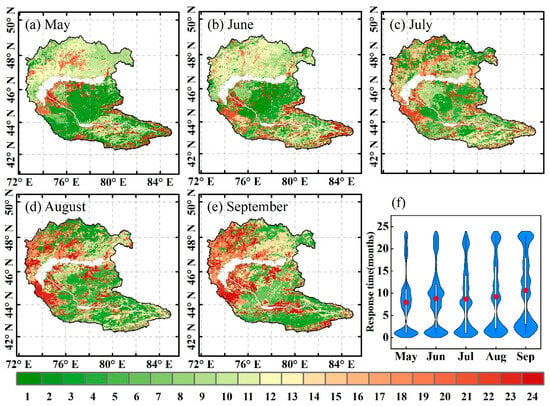
Figure 4.
SPEI time scales for which the maximum correlation between the monthly NDVI and SPEI was recorded for the period 2001–2022. (a–e) represent May to September, while (f) is the violin plot of the maximum correlation coefficient corresponding to May–September, with the red dots indicating the mean values.
The research objective of this study was to compare the differences in the dependence of different types of vegetation (irrigated croplands, rainfed croplands, forestlands, grasslands) on water deficit and differences in the probability under drought stress in the Ili River Transboundary Basin. According to the response time of the various types of vegetation to water deficits (Figure 5), croplands exhibited the quickest response, indicating that croplands are more susceptible to drought. Additionally, irrigated croplands exhibited the longest response time in June, far surpassing that of rainfed croplands, indicating that irrigation measures are more effective in combating drought in June. During May to July, forests showed the longest response time to water deficits, while, in August and September, grasslands exhibited the longest response time.
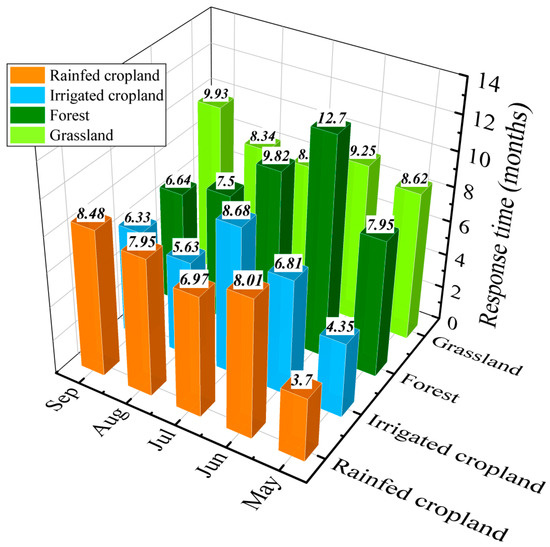
Figure 5.
Response time of different vegetation types.
This study further explores the variations across vegetation response to drought in different climate dryness areas. The results show that the response time in the arid zone showed a monthly increasing trend (Figure 6). Conversely, the response time in the semi-arid zone was at a lower level during the growing season, suggesting that the vegetation in the semi-arid zone is more susceptible to drought than in the arid zone.
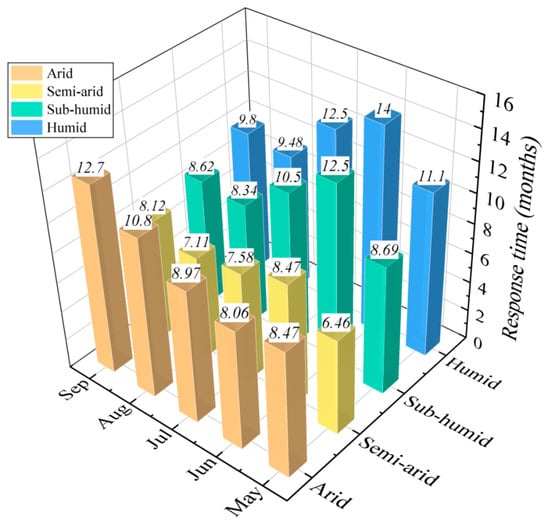
Figure 6.
The response time of vegetation under different climate dryness deficiency levels.
4.3. Assessment of Vegetation Vulnerability
4.3.1. Reliability Validation of the Copula Model
Before conducting a vegetation vulnerability analysis, it is essential to validate its reliability. Therefore, the reliability of the copula model was verified by comparing paired observations of NDVI-SPEI with estimated NDVI distributions based on different SPEI values. The conditional NDVI distribution for different SPEI values was calculated using Equation (7). Six pixels were randomly selected from four vegetation types—rainfed croplands, irrigated croplands, forests, and grasslands (Figure 1c)—for model validation. Each column in the model validation represents the conditional PDF (Probability Density Function) of the NDVI for a specific SPEI value, normalized to a range of 0 to 100%, with darker colors indicating more concentrated distributions. The comparison results (Figure 7) show that most observed NDVI-SPEI pairs fall within regions where simulated distributions are more concentrated. This suggests that the copula model accurately simulates the correlation between vegetation status and water deficit and is able to reliably assess vegetation vulnerability.
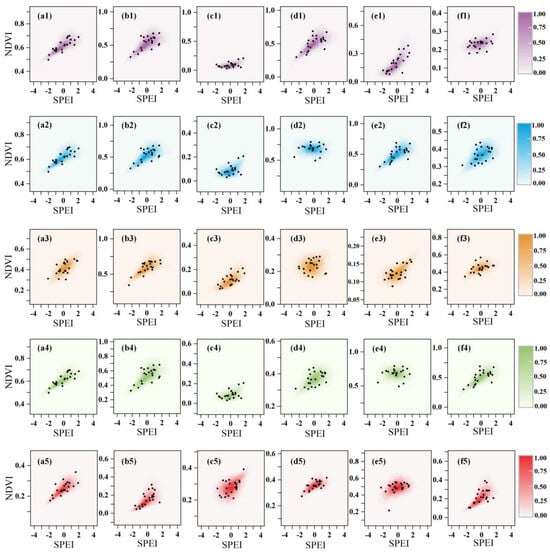
Figure 7.
Comparison of estimated NDVI distribution with NDVI-SPEI values observed in pairs from May to September. (a) Rainfed croplands, (b) irrigated croplands, (c) forests, (d–f) grasslands. (a1–f1) represent May, (a2–f2) represent June, (a3–f3) represent July, (a4–f4) represent August, and (a5–f5) represent September.
4.3.2. Probability of Vegetation Loss Under Different Drought Scenarios
In this study, the conditional probabilities were systematically evaluated. Additionally, the NDVI values at the 0.4, 0.3, 0.2, and 0.1 quantiles represented varying degrees of vegetation health deterioration. The lower the NDVI percentile, the more severe the vegetation loss and ecosystem degradation [40]. Figure 8 and Figure 9 and Figure A5, Figure A6 and Figure A7 depict the probabilities of vegetation falling below different percentiles during the months of May to September under the three drought scenarios (moderate drought scenario, severe drought scenario, and extreme drought scenario). The Pave is the mean probability.
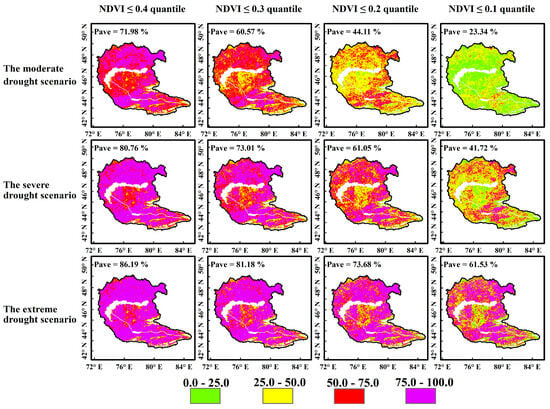
Figure 8.
Conditional probability of vegetation loss in May under different scenarios, i.e., 0.4, 0.3, 0.2, and 0.1, which are considered uniformly.
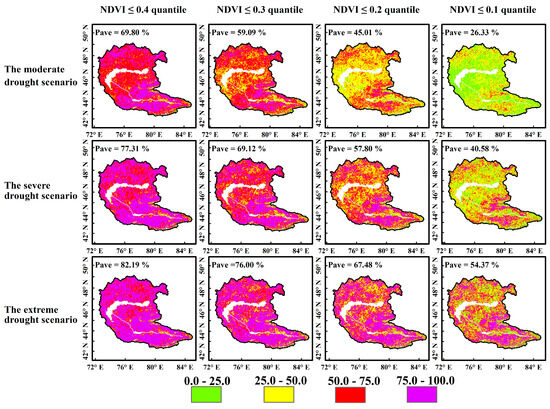
Figure 9.
Conditional probability of vegetation loss in September under different scenarios, i.e., 0.4, 0.3, 0.2, and 0.1, which are considered uniformly.
From the first column of Figure 8, it can be observed that the mean probability of the NDVI dropping below 0.4 in May is 71.98%, 80,76% and 86.19%, respectively. As the drought severity increases, the likelihood of vegetation loss increases, holding true for other NDVI quantiles (NDVI below 0.3, NDVI below 0.2, and NDVI below 0.1) in May as well. The likelihood of the NDVI dropping to 0.4 under moderate drought conditions (71.98%) differs by 14.21% compared with that under extreme drought (86.19%). When the NDVI drops to 0.3, 0.2, and 0.1, the differences between the two drought scenarios increase from 20.61% to 29.57% and then to 38.19%. Similar patterns are observed in June, July, August, and September. Hence, vegetation loss may exhibit a positive response to the severity of the moisture deficit, indicating an increase in vegetation vulnerability as drought conditions worsen.
On the temporal scale, the mean probability of the NDVI falling below 0.4 in June is 77.96%, 85.36%, and 89.43%, respectively (Figure A5). The conditional probabilities of loss of vegetation in June are higher than those in May (the first column of Figure 8), July (the first column of Figure A6), August (the first column of Figure A7), and September (the first column of Figure 9). Additionally, when studying the NDVI affected by the 0.3, 0.2, and 0.1 quantiles, it is observed that the probability of loss in June is greater. Therefore, throughout the entire growing season, vegetation vulnerability is at its highest in June, followed by July, May, August, and September.
Based on conditional probability, drought-vulnerable areas under different drought scenarios were classified into four categories: highly vulnerable areas (75–100%), moderately highly vulnerable areas (50–75%), moderately vulnerable areas (25–50%), and low vulnerability areas (0.00–25%). The analysis indicates that, under the NDVI ≤ 0.2 condition, the proportion of highly vulnerable areas in the extreme drought scenario from May to September exhibits a trend of first increasing and then decreasing (Figure A8, Figure A9, Figure A10, Figure A11 and Figure A12). In May (Figure A8), the proportion of highly vulnerable areas is 57.44%, rising to the highest value of the growing season (63.29%) in June (Figure A9), and then decreasing to 56.62% in July (Figure A10), further dropping to 48.81% in August (Figure A11), and finally reaching 44.91% in September (Figure A12). This trend suggests that June is the period when vegetation is most severely affected by drought. Furthermore, the intensification of drought expands the extent of highly vulnerable areas. When NDVI ≤ 0.2, the proportion of highly vulnerable areas in May rapidly increases from 3.09% under moderate drought conditions to 57.44% under extreme drought conditions. Similar patterns are observed across other months and NDVI quantiles. These findings indicate that, as the drought severity increases, the vegetation vulnerability continues to rise, leading to the further expansion of highly drought-vulnerable areas.
Policymakers tend to prioritize regions that are susceptible to water shortages. Identifying areas within the study region that are prone to drought from a probabilistic standpoint is a key application of current drought impact analysis. As the severity of drought exacerbates, spatial variations in the vegetation loss probability among pixels become increasingly apparent. For instance, under moderate drought conditions, as illustrated in the top row panels of Figure 8, all pixels may experience similar levels of vegetation loss, making it difficult to identify hotspot areas with higher probabilities of vegetation loss. However, as drought events progress to extreme and severe levels, significant spatial disparities emerge, particularly toward the bottom-right corner of the panels. In May (Figure 8), higher probabilities are observed in the southern and eastern border regions. These regions correspond administratively to the eastern and southern parts of the Almaty region in Kazakhstan and the eastern part of Ayagoz City in East Kazakhstan. In June (Figure A5), the vegetation loss probabilities remain elevated throughout Almaty City, while drought-prone areas in East Kazakhstan begin expanding northward. Subsequently, in July (Figure A6), the extent of drought-prone areas outside of China narrows, focusing mainly on the southeastern part of the city of Almaty, while, at the same time, the likelihood of vegetation loss in the Ili Valley increases. Moving into August (Figure A7), drought-prone areas are concentrated in the southeastern part of Almaty City and the Ili Valley, including the southern part of Nilka, Gongliu, and Qapqal Xibe Autonomous County, as well as the northern parts of Yining and Hocheng. Transitioning into September (Figure 9), drought-prone areas continue to be concentrated in the southeastern part of Almaty City and the Ili River Valley. However, compared to August, there is an improvement in vegetation loss within the Ili River Valley.
The probabilities of loss across various vegetation types were explored in the Ili River Transboundary Basin (Figure 10). Taking the NDVI below the 20th percentile as an example, the probability of loss for rainfed and irrigated croplands decreases monthly under all three drought scenarios. Furthermore, using May as an example, the disparity in loss probability between rainfed and irrigated croplands increases with worsening drought conditions, rising from 2.13% to 9.81% and 12.59%. Similar trends can be observed from Figure A13, Figure A14 and Figure A15, indicating that, as drought severity increases, the role of irrigation measures becomes more significant for irrigated croplands. The loss probability of forests shows a monthly increasing trend. Additionally, the differences in the vegetation loss probability across different climate dryness zones were explored (Figure 11 and Figure A16). It was found that the probability of vegetation loss is highest in the semi-arid zone, especially during the summer (June–August).
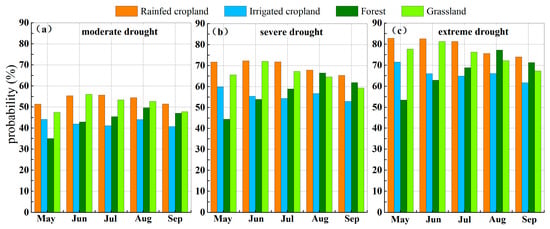
Figure 10.
Probability of loss of rainfed croplands, irrigated croplands, forests, and grasslands below the 20th-percentile NDVI under moderate, severe, and extreme drought scenarios. (a) probability of loss of rainfed croplands, irrigated croplands, forests, and grasslands below the 20th-percentile NDVI under moderate drought scenario, (b) probability of loss of rainfed croplands, irrigated croplands, forests, and grasslands below the 20th-percentile NDVI under severe drought scenario, (c) probability of loss of rainfed croplands, irrigated croplands, forests, and grasslands below the 20th-percentile NDVI under extreme drought scenario.
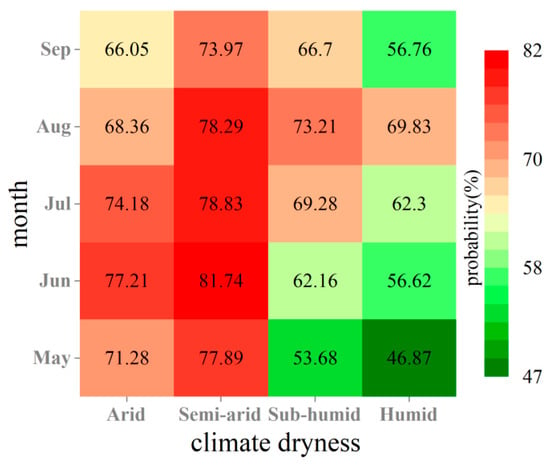
Figure 11.
The average probability of vegetation loss in the months of the growing season under different climate dryness conditions.
5. Discussion
This study found that vegetation is most sensitive to water deficits in June, a phenomenon which may be attributed to the rapid growth of vegetation during this period, requiring large amounts of water to sustain growth. Additionally, vegetation in the central arid region of the Ili River Valley is not significantly affected by water deficits. This is because the vegetation condition in this area is influenced by multiple factors, including temperature, solar radiation, humidity, and human activities. The land cover type in this region is irrigated cropland, which is heavily influenced by human intervention, thereby reducing the vegetation’s dependence on water availability. The study also examined the response times of different vegetation types in arid regions to water deficits. By comparing the response times of various vegetation types to drought, it was found that croplands are more vulnerable to drought, which is consistent with the findings of Srinidhi [25]. Moreover, grasslands exhibited the longest response times to drought in August and September. Research has shown that precipitation is the primary factor affecting grassland changes in Central Asia [41], especially in low-elevation areas where moisture availability significantly impacts grassland health. The grasslands in the Ili River Transboundary Basin are primarily located in low-elevation areas, and precipitation and its seasonal distribution are the main factors limiting grassland growth. The delayed response of grasslands to drought may be related to the physiological mechanisms of these ecosystems, allowing plant species in these areas to adapt to prolonged water deficits, as supported by previous studies [42,43]. When examining the response times of vegetation to drought in different regions, it is evident that vegetation adopts distinct strategies to cope with water shortages. In arid, semi-arid, and semi-humid regions, vegetation is often affected by water deficits and has developed physiological adaptations, such as more efficient water conservation mechanisms and deeper root systems, to cope with challenging environmental conditions related to water supply.
The study found that, as drought severity increases, the probability of vegetation loss also increases, aligning with the findings of Han et al. [26]. Furthermore, extreme drought has the greatest impact on vegetation, while moderate drought has the least, consistent with the results of Zhu et al. [44]. By comparing the loss probabilities across different arid and humid regions, it was found that semi-arid areas have the highest loss probability during the growing season. The moisture use efficiency of the vegetation in different hydroclimatic regions can explain this phenomenon during drought events [45]. In arid regions, moisture use efficiency increases as drought intensifies; however, in semi-arid or semi-humid regions, the efficiency may decrease [46]. Vegetation in arid areas has evolved physiological mechanisms to adapt to water scarcity, such as enhanced water absorption and minimized water loss [47,48,49]. Comparing the loss probabilities of different vegetation types revealed that the probability of loss in irrigated croplands decreases on a monthly basis. This is likely due to irrigation measures alleviating drought stress on crops [47,48,49,50]. At the beginning of the growing season, the probability of forest loss is relatively low, a phenomenon which may be due to forest ecosystems more easily accessing deep soil moisture, making them less susceptible to drought stress [51]. In contrast, grasslands and croplands, with shallower root systems, are more reliant on precipitation recharge [52]. The monthly increase in forest loss probability could be attributed to the fact that most of the forests in the Ili River Transboundary Basin are located at high altitudes, with studies indicating that vegetation in high-altitude areas is primarily affected by moisture and heat. In August and September, as temperatures continue to rise, sustained heat stress increases the evaporative demand of forests. When the water supply is insufficient to meet this demand, the forest ecosystem becomes more vulnerable under drought stress [51].
The TerraClimate dataset was chosen for this study due to its broad coverage, high temporal resolution, and suitability for analyzing long-term climate variability [53]. This dataset has been widely used in studies examining the relationship between vegetation and drought. However, during the research process, we encountered the challenge of data singularity. A single data source may introduce potential uncertainties or biases which could compromise the robustness of the results. To address this issue, we plan to incorporate multiple remote sensing datasets for cross-validation and supplementary analysis in future research. By leveraging the advantages of various data sources, we aim to mitigate potential biases caused by data singularity, thereby significantly enhancing the stability and reliability of the results. The inclusion of multiple datasets not only strengthens the consistency of the analysis, but also allows for further verification of the research conclusions across different data sources. When selecting data, we prioritized factors such as spatial and temporal resolution, coverage, and relevance to the research objectives. These criteria ensure the scientific rigor of the data while combining the strengths of a single dataset with the collaborative benefits of multi-source analysis to robustly support the reliability and stability of the results.
The Ili River Transboundary Basin is located in Central Asia, where vegetation growth is primarily influenced by water availability. A bivariate probability framework established using the SPEI and NDVI can effectively analyze the impact of drought on these water-scarce regions. However, vegetation is also affected by other factors, including human activities such as grazing and urban development [54,55], natural disasters like wildfires and pests [56], and other climatic events such as heatwaves [57]. Ignoring how drought interacts with other variables could lead to uncertainties in experimental results [58]. Additionally, a limitation of copula-based probability models lies in the recording period of the data, as the finite length of data may make the results less reliable.
To mitigate the future impact of drought on the Ili River Transboundary Basin, comprehensive strategies should be developed based on vegetation types, climatic zones, and the spatiotemporal patterns of drought-vulnerable areas. First, improving irrigation efficiency is crucial. The adoption of efficient irrigation techniques, such as drip irrigation, and the optimization of water resource allocation can significantly reduce the impact of severe drought on agriculture. Some studies suggest that Central Asia will experience a trend of drought during the summer [59]. Considering the fact that vegetation is more susceptible to drought in the summer, the Ili River Transboundary Basin, especially its semi-arid areas, may face ecological degradation, which could alter the carbon cycle and pose risks to the region’s sustainable development. Therefore, special attention should be given to the semi-arid areas of the region, particularly during the summer months. Drought early warning systems and rapid interventions should be prioritized in these areas, while arid regions should focus on strengthening groundwater management and long-term water resource regulation to address potential ecological losses. Additionally, the vulnerability of different vegetation types to drought exhibits temporal variation. For instance, grasslands are most vulnerable to drought in June, and measures such as limiting overgrazing and increasing the water supply should be implemented. Forests, on the other hand, are most vulnerable in August and September, and their resilience can be enhanced through the selection of drought-resistant tree species and optimized forest management. Spatially, drought-vulnerable areas shift from being concentrated in East Kazakhstan before July to the Ili River Valley in Xinjiang and southeastern Almaty by August. Therefore, strengthening cross-border cooperation, particularly in sharing water resource management expertise and establishing joint drought emergency systems, is of paramount importance. The comprehensive implementation of these measures can effectively alleviate the future impact of drought on regional ecosystems and agriculture, enhance overall drought resilience, and promote sustainable development in the region.
6. Conclusions
This study employed a bivariate copula model to quantify the response of vegetation to drought in the Ili River Transboundary Basin from 2001 to 2022. Firstly, the dependence of vegetation on water deficits was determined by calculating the correlation between the NDVI and SPEI. Then, a bivariate copula model was utilized to quantify the conditional probabilities of vegetation loss under various drought conditions. Based on this analysis, the study compared the differences in drought response among different vegetation types (rainfed croplands, irrigated croplands, forests, and grasslands) and different climatic dryness areas. The primary research findings are as follows.
The vegetation in the Ili River Transboundary Basin is most sensitive to water deficits in June. Irrigated croplands have the longest response time to water deficits in June, forestlands have the longest response time to water deficits from May to July, and grasslands have the longest response time from August to September. Vegetation in the semi-arid zone responds faster to water deficits than in the arid zone.
As the severity of drought increases, the probability of vegetation loss also rises. In June, the vulnerability of vegetation in the Ili River Transboundary Basin is at its highest, with the proportion of highly drought-prone vegetation under extreme drought reaching 63.29%. Additionally, when NDVI ≤ 0.2, the proportion of highly drought-prone vegetation in May increases rapidly from 3.09% under moderate drought conditions to 57.44% under extreme drought conditions. These results indicate that June is the period when vegetation is most susceptible to drought, and, as the drought intensifies, the extent of highly drought-prone vegetation also increases. Drought-prone regions are primarily located in Almaty and the Ayagoz City in East Kazakhstan before July, shifting thereafter to the Ili River Valley in Xinjiang, China, and the southeastern Almaty region.
Rainfed croplands are more vulnerable to drought than irrigated croplands, and the higher the degree of drought, the more significant the effect of irrigation measures on irrigated croplands. Grasslands are most vulnerable in June, while forests are most vulnerable in August and September. For the different climatic dryness regions, the probability of vegetation loss is higher in the semi-arid zone than in the arid zone, with the highest probability in the semi-arid zone during the summer months (June–August).
Author Contributions
Writing—review and editing, writing—original draft, software, validation, visualization, Y.L.; writing—review and editing, methodology, supervision, J.Y.; resources, funding acquisition, J.W.; writing—review and editing, Z.Z.; software, H.X.; software, Z.M.; writing—review and editing, L.G. All authors have read and agreed to the published version of the manuscript.
Funding
This research was funded by the Third Xinjiang Scientific Expedition Program, grant number 2022xjkk0600.
Data Availability Statement
The data can be obtained upon request from the corresponding author.
Conflicts of Interest
The authors declare no conflicts of interest.
Appendix A
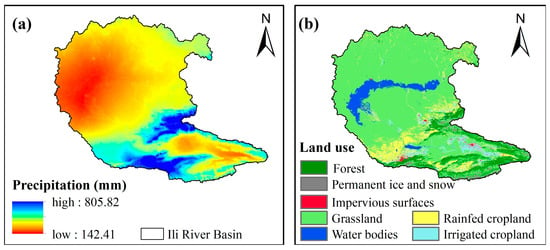
Figure A1.
Study area. (a) Multi-year average precipitation in the Ili River Transboundary Basin. (b) Land cover types in the Ili River Transboundary Basin.
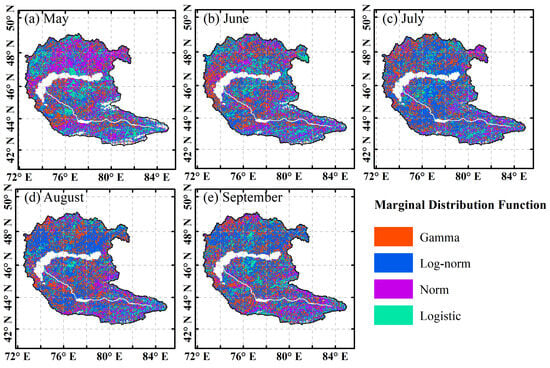
Figure A2.
The best marginal distribution function for the NDVI.
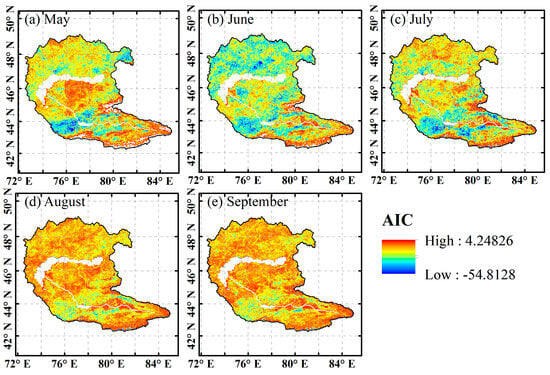
Figure A3.
The AIC value corresponding to the optimal copula.
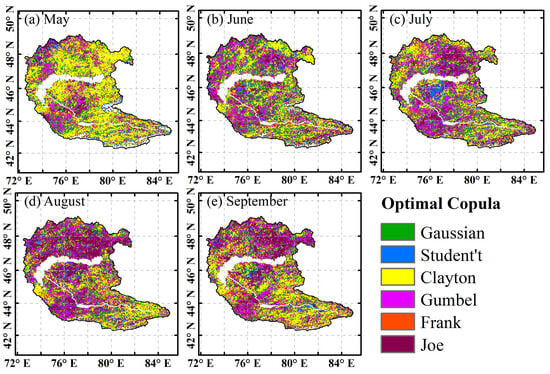
Figure A4.
Optimal copula.
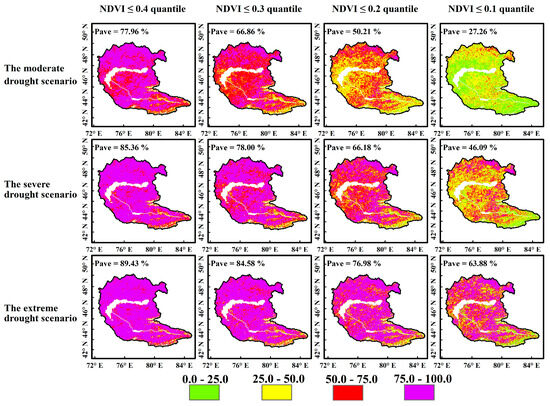
Figure A5.
Conditional probability of vegetation loss in June under the moderate drought scenario, severe drought scenario, and extreme drought scenario, i.e., 0.4, 0.3, 0.2, and 0.1, such scenarios being considered uniformly.
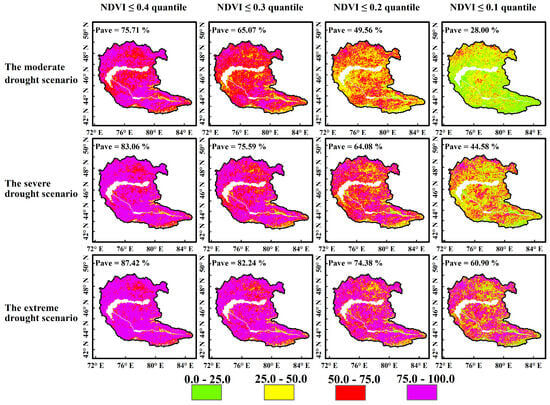
Figure A6.
Conditional probability of vegetation loss in July under different scenarios, i.e., 0.4, 0.3, 0.2, and 0.1, which are considered uniformly.

Figure A7.
Conditional probability of vegetation loss in August under the moderate drought scenario, severe drought scenario, and extreme drought scenario, i.e., 0.4, 0.3, 0.2, and 0.1, such scenarios being considered uniformly.
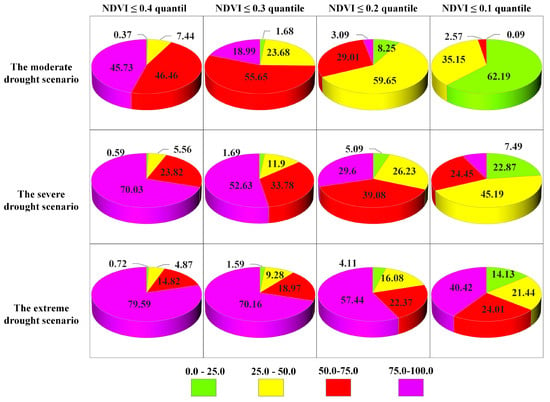
Figure A8.
Percentage distribution of different levels of drought-prone areas in May.
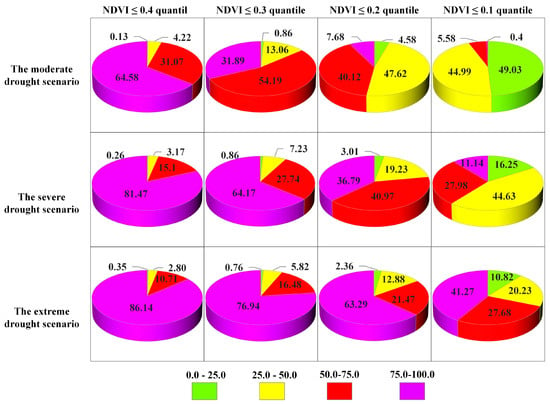
Figure A9.
Percentage distribution of different levels of drought-prone areas in June.
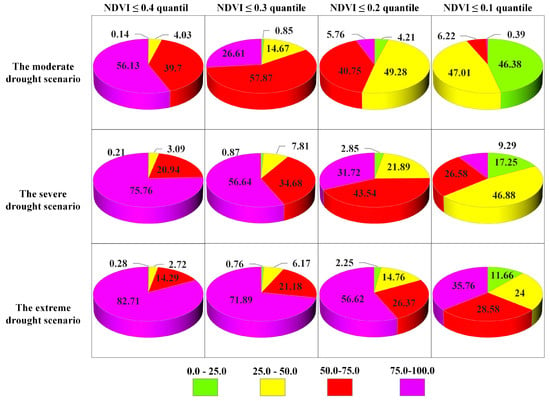
Figure A10.
Percentage distribution of different levels of drought-prone areas in July.

Figure A11.
Percentage distribution of different levels of drought-prone areas in August.
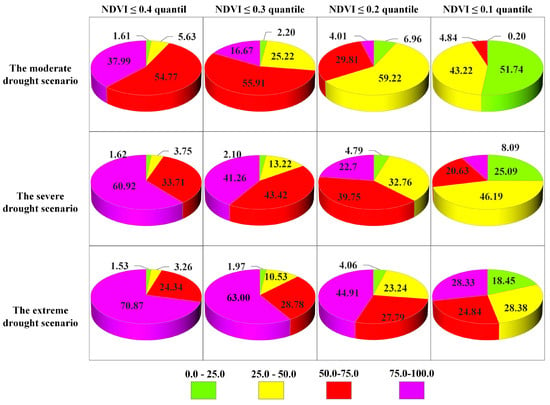
Figure A12.
Percentage distribution of different levels of drought-prone areas in September.
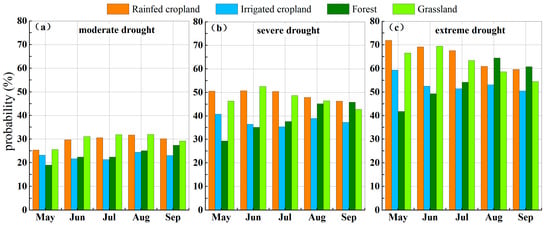
Figure A13.
Probability of loss of rainfed croplands, irrigated croplands, forests, and grasslands below the 10th-percentile NDVI under moderate, severe, and extreme drought scenarios. (a) probability of loss of rainfed croplands, irrigated croplands, forests, and grasslands below the 10th-percentile NDVI under moderate drought scenario, (b) probability of loss of rainfed croplands, irrigated croplands, forests, and grasslands below the 10th-percentile NDVI under severe drought scenario, (c) probability of loss of rainfed croplands, irrigated croplands, forests, and grasslands below the 10th-percentile NDVI under extreme drought scenario.
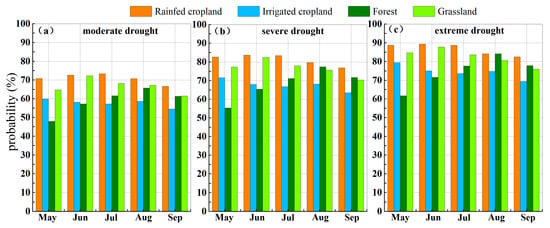
Figure A14.
Probability of loss of rainfed croplands, irrigated croplands, forests, and grasslands below the 30th-percentile NDVI under moderate, severe, and extreme drought scenarios. (a) probability of loss of rainfed croplands, irrigated croplands, forests, and grasslands below the 30th-percentile NDVI under moderate drought scenario, (b) probability of loss of rainfed croplands, irrigated croplands, forests, and grasslands below the 30th-percentile NDVI under severe drought scenario, (c) probability of loss of rainfed croplands, irrigated croplands, forests, and grasslands below the 30th-percentile NDVI under extreme drought scenario.

Figure A15.
Probability of loss of rainfed croplands, irrigated croplands, forests, and grasslands below the 40th-percentile NDVI under moderate, severe, and extreme drought scenarios. (a) probability of loss of rainfed croplands, irrigated croplands, forests, and grasslands below the 40th-percentile NDVI under moderate drought scenario, (b) probability of loss of rainfed croplands, irrigated croplands, forests, and grasslands below the 40th-percentile NDVI under severe drought scenario, (c) probability of loss of rainfed croplands, irrigated croplands, forests, and grasslands below the 40th-percentile NDVI under extreme drought scenario.
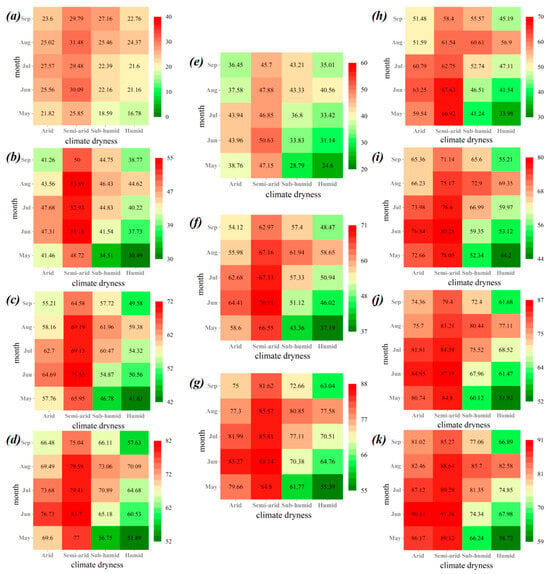
Figure A16.
The average probability of vegetation loss in the months of the growing season under different climate dryness conditions. (a–d) are the NDVI values below the 10th, 20th, 30th, and 40th percentiles under moderate dryness. (e–g) are the NDVI values below the 10th, 20th, and 40th percentiles under severe dryness. (h–k) are the NDVI values below the 10th, 20th, 30th, and 40th percentiles under extreme dryness.
References
- IPCC. Climate Change 2021: The Physical Science Basis (Contribution of Working Group I to the Sixth Assessment Report of the Intergovernmental Panel on Climate Change); IPCC: Geneve, Switzerland, 2021. [Google Scholar]
- Li, H.; Li, Z.; Chen, Y.; Xiang, Y.; Liu, Y.; Kayumba, P.M.; Li, X. Drylands face potential threat of robust drought in the CMIP6 SSPs scenarios. Environ. Res. Lett. 2021, 16, 114004. [Google Scholar] [CrossRef]
- Guo, W.; Huang, S.; Huang, Q.; Leng, G.; Mu, Z.; Han, Z.; Wei, X.; She, D.; Wang, H.; Wang, Z. Drought trigger thresholds for different levels of vegetation loss in China and their dynamics. Agric. For. Meteorol. 2023, 331, 109349. [Google Scholar] [CrossRef]
- Lesk, C.; Anderson, W.; Rigden, A.; Coast, O.; Jägermeyr, J.; McDermid, S.; Davis, K.F.; Konar, M. Compound heat and moisture extreme impacts on global crop yields under climate change. Nat. Rev. Earth Environ. 2022, 3, 872–889. [Google Scholar] [CrossRef]
- Lindner, M.; Maroschek, M.; Netherer, S.; Kremer, A.; Barbati, A.; Garcia-Gonzalo, J.; Seidl, R.; Delzon, S.; Corona, P. Climate change impacts, adaptive capacity, and vulnerability of European forest ecosystems. For. Ecol. Manag. 2010, 259, 698–709. [Google Scholar] [CrossRef]
- Fang, W.; Huang, S.; Huang, Q.; Huang, G.; Wang, H.; Leng, G.; Wang, L.; Li, P.; Ma, L. Bivariate probabilistic quantification of drought impacts on terrestrial vegetation dynamics in mainland China. J. Hydrol. 2019, 577, 123980. [Google Scholar] [CrossRef]
- Yang, J.; Wu, J.; Liu, L.; Zhou, H.; Gong, A.; Han, X.; Zhao, W. Responses of winter wheat yield to drought in the North China Plain: Spatial–temporal patterns and climatic drivers. Water 2020, 12, 3094. [Google Scholar] [CrossRef]
- Liu, S.; Li, T.; Liu, B.; Xu, C.; Zhu, Y.; Xiao, L. Grassland vegetation decline is exacerbated by drought and can be mitigated by soil improvement in Inner Mongolia, China. Sci. Total Environ. 2024, 15, 168464. [Google Scholar] [CrossRef] [PubMed]
- Yang, J.; Li, Y.; Zhou, L.; Zhang, Z.; Zhou, H.; Wu, J. Effects of temperature and precipitation on drought trends in Xinjiang, China. J. Arid Land 2024, 16, 1098–1117. [Google Scholar] [CrossRef]
- Ding, Y.; Xu, J.; Wang, X.; Peng, X.; Cai, H. Spatial and temporal effects of drought on Chinese vegetation under different coverage levels. Sci. Total Environ. 2020, 716, 137166. [Google Scholar] [CrossRef]
- Liu, X.; Zhu, X.; Li, S.; Liu, Y.; Pan, Y. Changes in Growing Season Vegetation and Their Associated Driving Forces in China during 2001–2012. Remote Sens. 2015, 7, 15517–15535. [Google Scholar] [CrossRef]
- Jiang, L.; Jiapaer, G.; Bao, A.; Guo, H.; Ndayisaba, F. Vegetation dynamics and responses to climate change and human activities in Central Asia. Sci. Total Environ. 2017, 599–600, 967–980. [Google Scholar] [CrossRef] [PubMed]
- Qi, X.; Jia, J.; Liu, H.; Lin, Z. Relative importance of climate change and human activities for vegetation changes on China’s silk road economic belt over multiple timescales—ScienceDirect. Catena 2019, 180, 224–237. [Google Scholar] [CrossRef]
- Jin, H.; Vicente-Serrano, S.M.; Tian, F.; Cai, Z.; Conradt, T.; Boincean, B.; Murphy, C.; Farizo, B.A.; Grainger, S.; López-Moreno, J.I. Higher vegetation sensitivity to meteorological drought in autumn than spring across European biomes. Commun. Earth Environ. 2023, 4, 299. [Google Scholar] [CrossRef]
- Li, Y.; Dong, G.; Xue, H.; Zheng, Y.; Lian, Y. Effects of Multi-time Scale Meteorological Drought on Vegetation in the Yellow River Basin from 1982 to 2020. J. Soil Water Conserv. 2024, 38, 187–196. [Google Scholar]
- Poonia, V.; Jha, S.; Goyal, M.K. Copula based analysis of meteorological, hydrological and agricultural drought characteristics across Indian river basins. Int. J. Climatol. 2021, 41, 4637–4652. [Google Scholar] [CrossRef]
- Goswami, P.; Hazra, B.; Kumar, G. Copula-based probabilistic characterization of precipitation extremes over North Sikkim Himalaya. Atmos. Res. 2018, 212, 273–284. [Google Scholar] [CrossRef]
- Uttarwar, S.B.; Barma, S.D.; Mahesha, A. Bivariate Modeling of Hydroclimatic Variables in Humid Tropical Coastal Region Using Archimedean Copulas. J. Hydrol. Eng. 2020, 25, 05020026. [Google Scholar] [CrossRef]
- Nelsen Roger, B.; Quesada-Molina, J.J.; Rodríguez-Lallena, J.A.; Úbeda-Flores, M. Distribution functions of copulas: A class of bivariate probability integral transforms. Stat. Probab. Lett. 2001, 54, 277–282. [Google Scholar] [CrossRef]
- Kao, S.C.; Govindaraju, R.S. A copula-based joint deficit index for droughts. J. Hydrol. 2010, 380, 121–134. [Google Scholar] [CrossRef]
- Chen, L.; Singh, V.P.; Guo, S.L.; Mishra, A.K.; Guo, J. Drought Analysis Using Copulas. J. Hydrol. Eng. 2013, 18, 797–808. [Google Scholar] [CrossRef]
- Huang, S.; Hou, B.; Chang, J.; Huang, Q.; Chen, Y. Copulas-based probabilistic characterization of the combination of dry and wet conditions in the Guanzhong Plain, China. J. Hydrol. 2014, 519, 3204–3213. [Google Scholar] [CrossRef]
- Mirabbasi, R.; Fakheri-Fard, A.; Dinpashoh, Y. Bivariate drought frequency analysis using the copula method. Theor. Appl. Climatol. 2012, 108, 191–206. [Google Scholar] [CrossRef]
- Madadgar, S.; Aghakouchak, A.; Farahmand, A.; Davis, S.J. Probabilistic estimates of drought impacts on agricultural production. Geophys. Res. Lett. 2017, 44, 7799–7807. [Google Scholar] [CrossRef]
- Jha, S.; Das, J.; Sharma, A.; Hazra, B.; Goyal, M.K. Probabilistic evaluation of vegetation drought likelihood and its implications to resilience across India. Glob. Planet. Change 2019, 176, 23–25. [Google Scholar] [CrossRef]
- Han, F.; Ling, H.; Yan, J.; Deng, M.; Deng, X.; Gong, Y.; Wang, W. Shift in the migration trajectory of the green biomass loss barycenter in Central Asia. Sci. Total Environ. 2022, 847, 157656. [Google Scholar] [CrossRef] [PubMed]
- Muthuvel, D.; Sivakumar, B.; Mahesha, A. Future global concurrent droughts and their effects on maize yield. Sci. Total Environ. 2023, 855, 158860. [Google Scholar] [CrossRef] [PubMed]
- Wang, L.; Good, S.P.; Caylor, K.K. Global synthesis of vegetation control on evapotranspiration partitioning. Geophys. Res. Lett. 2014, 41, 6753–6757. [Google Scholar] [CrossRef]
- Yuan, W.; Piao, S.; Qin, D.; Dong, W.; Xia, J.; Lin, H.; Chen, M. Influence of vegetation growth on the enhanced seasonality of atmospheric CO2. Glob. Biogeochem. Cycle 2018, 32, 32–41. [Google Scholar] [CrossRef]
- Li, H.; Li, Y.; Huang, G.; Sun, J. Quantifying effects of compound dry-hot extremes on vegetation in Xinjiang (China) using a vine-copula conditional probability model. Agric. For. Meteorol. 2021, 311, 108658. [Google Scholar] [CrossRef]
- Li, H.; Li, Y.; Huang, G.; Sun, J. Probabilistic assessment of crop yield loss to drought time-scales in Xinjiang, China. Int. J. Climatol. 2021, 41, 4077–4094. [Google Scholar] [CrossRef]
- Han, W.; Guan, J.; Zheng, J.; Liu, Y.; Ju, X.; Liu, L.; Li, J.; Mao, X.; Li, C. Probabilistic assessment of drought stress vulnerability in grasslands of Xinjiang, China. Front. Plant Sci. 2023, 14, 1143863. [Google Scholar] [CrossRef]
- Li, Z.; Zheng, F.; Liu, W.; Flanagan, D.C. Spatial distribution and temporal trends of extreme temperature and precipitation events on the Loess Plateau of China during 1961–2007. Quat. Int. 2010, 226, 92–100. [Google Scholar] [CrossRef]
- Trabucco, A.; Zomer, R. Global aridity index and potential evapotranspiration (ET0) climate database v2. CGIAR Consort. Spat. Inf. 2018, 10, m9. [Google Scholar]
- Monteith; Lennox, J. Evaporation and environment. Symp. Soc. Exp. Biol. 1965, 19, 205–234. [Google Scholar] [PubMed]
- Borgomeo, E.; Pflug, G.; Hall, J.W.; Hochrainer-Stigler, S. Assessing water resource system vulnerability to unprecedented hydrological drought using copulas to characterize drought duration and deficit. Water Resour. Res. 2015, 51, 8927–8948. [Google Scholar] [CrossRef] [PubMed]
- Campos-Taberner, M.; Moreno-Martínez, Á.; García-Haro, F.J.; Camps-Valls, G.; Robinson, N.P.; Kattge, J.; Running, S.W. Global Estimation of Biophysical Variables from Google Earth Engine Platform. Remote Sens. 2018, 10, 1167. [Google Scholar] [CrossRef]
- Guo, Y.; Huang, S.; Huang, Q.; Wang, H.; Fang, W. Copulas-based bivariate socioeconomic drought dynamic risk assessment in a changing environment. J. Hydrol. 2019, 575, 1052–1064. [Google Scholar] [CrossRef]
- Sadegh, M.; Ragno, E.; Aghakouchak, A. Multivariate Copula Analysis Toolbox (MvCAT): Describing dependence and underlying uncertainty using a Bayesian framework. Water Resour. Res. 2017, 53, 5166–5183. [Google Scholar] [CrossRef]
- Fang, W.; Huang, S.; Huang, Q.; Huang, G.; Wang, H.; Leng, G.; Wang, L.; Li, P.; Ma, L. Probabilistic assessment of remote sensing-based terrestrial vegetation vulnerability to drought stress of the Loess Plateau in China. Remote Sens. Environ. 2019, 232, 111290. [Google Scholar] [CrossRef]
- Chen, T.; Tang, G.; Yuan, Y.; Guo, H.; Xu, Z.; Jiang, G.; Chen, X. Unraveling the relative impacts of climate change and human activities on grassland productivity in Central Asia over last three decades. Sci. Total Environ. 2020, 743, 140649. [Google Scholar] [CrossRef]
- Anderegg, W.R.L.; Schwalm, C.; Biondi, F.; Camarero, J.J.; Koch, G.; Litvak, M.; Ogle, K.; Shaw, J.D.; Shevliakova, E.; Williams, A.P. Pervasive drought legacies in forest ecosystems and their implications for carbon cycle models. Science 2015, 349, 528–532. [Google Scholar] [CrossRef] [PubMed]
- Wen, Y.; Liu, X.; Xin, Q.; Wu, J.; Xu, X.; Pei, F.; Li, X.; Du, G.; Cai, Y.; Lin, K. Cumulative Effects of Climatic Factors on Terrestrial Vegetation Growth. J. Geophys. Res.-Biogeosci. 2019, 124, 789–806. [Google Scholar] [CrossRef]
- Zhu, S.; Xiao, Z.; Luo, X.; Zhang, H.; Huo, Z. Multidimensional Response Evaluation of Remote-Sensing Vegetation Change to Drought Stress in the Three-River Headwaters, China. IEEE J. Sel. Top. Appl. Earth Observ. Remote Sens. 2020, 13, 6249–6259. [Google Scholar] [CrossRef]
- Zou, J.; Ding, J.; Welp, M.; Huang, S.; Liu, B. Using MODIS data to analyse the ecosystem water use efficiency spatial-temporal variations across Central Asia from 2000 to 2014. Environ. Res. 2020, 182, 108985. [Google Scholar] [CrossRef]
- Yang, Y.; Guan, H.; Batelaan, O.; Simmons, C. Contrasting response of water use efficiency to drought across global terrestrial ecosystems. Sci. Rep. 2016, 6, 23284. [Google Scholar] [CrossRef]
- Lundholm, B. Adaptations in arid ecosystems. Ecol. Bull. 1976, 24, 19–27. [Google Scholar]
- Schwinning, S.; Sala, O.E. Hierarchy of responses to resource pulses in arid and semi-arid ecosystems. Oecologia 2004, 141, 211–220. [Google Scholar] [CrossRef] [PubMed]
- Van der Molen, M.K.; Dolman, A.J.; Ciais, P.; Eglin, T.; Gobron, N.; Law, B.E.; Meir, P.; Peters, W.; Phillips, O.L.; Reichstein, M. Drought and ecosystem carbon cycling. Agric. For. Meteorol. 2011, 151, 765–773. [Google Scholar] [CrossRef]
- Li, F.; Zhang, M.; Zhao, Y.; Jiang, R. Influence of irrigation and groundwater on the propagation of meteorological drought to agricultural drought. Agric. Water Manag. 2023, 277, 108099. [Google Scholar]
- Sperry, J.S. Hydraulic constraints on plant gas exchange. Agric. For. Meteorol. 2000, 104, 13–23. [Google Scholar] [CrossRef]
- Shi, M.; Yuan, Z.; Shi, X.; Li, M.; Chen, F.; Li, Y. Drought assessment of terrestrial ecosystems in the Yangtze River Basin, China. J. Clean. Prod. 2022, 362, 132234. [Google Scholar] [CrossRef]
- Abatzoglou, J.T.; Dobrowski, S.Z.; Parks, S.A.; Hegewisch, K.C. Data Descriptor: TerraClimate, a high-resolution global dataset ofmonthly climate and climatic water balance from 1958–2015. Sci. Data 2018, 5, 170191. [Google Scholar] [CrossRef]
- Alimaev, I.; Kerven, C.; Torekhanov, A.; Behnke, R.; Smailov, K.; Yurchenko, V.; Sisatov, Z.; Shanbaev, K. The Impact of Livestock Grazing on Soils and Vegetation Around Settlements in Southeast Kazakhstan: South Kazakhstan Pasture Use Results; Springer: Berlin/Heidelberg, Germany, 2008; pp. 81–112. [Google Scholar]
- Guan, X.; Shen, H.; Li, X.; Gan, W.; Zhang, L. A long-term and comprehensive assessment of the urbanization-induced impacts on vegetation net primary productivity. Sci. Total Environ. 2019, 669, 342–352. [Google Scholar] [CrossRef]
- Bowman, D.M.J.S.; Kolden, C.A.; Abatzoglou, J.T.; Johnston, F.H.; Van Der Werf, G.R.; Flannigan, M. Vegetation fires in the Anthropocene. Nat. Rev. Earth Environ. 2020, 1, 500–515. [Google Scholar] [CrossRef]
- Hao, Y.; Hao, Z.; Fu, Y.; Feng, S.; Zhang, X.; Wu, X.; Hao, F. Probabilistic assessments of the impacts of compound dry and hot events on global vegetation during growing seasons. Environ. Res. Lett. 2021, 16, 074055. [Google Scholar] [CrossRef]
- Heimann, M.; Reichstein, M. Terrestrial ecosystem carbon dynamics and climate feedbacks. Nature 2008, 451, 289–292. [Google Scholar] [CrossRef] [PubMed]
- Jiang, J.; Zhou, T.; Chen, X.; Zhang, L. Future changes in precipitation over Central Asia based on CMIP6 projections. Environ. Res. Lett. 2020, 15, 054009. [Google Scholar] [CrossRef]
Disclaimer/Publisher’s Note: The statements, opinions and data contained in all publications are solely those of the individual author(s) and contributor(s) and not of MDPI and/or the editor(s). MDPI and/or the editor(s) disclaim responsibility for any injury to people or property resulting from any ideas, methods, instructions or products referred to in the content. |
© 2025 by the authors. Licensee MDPI, Basel, Switzerland. This article is an open access article distributed under the terms and conditions of the Creative Commons Attribution (CC BY) license (https://creativecommons.org/licenses/by/4.0/).